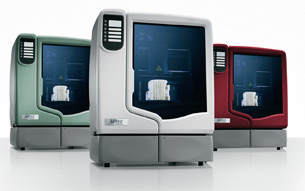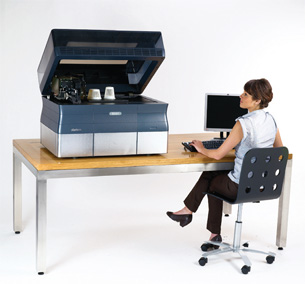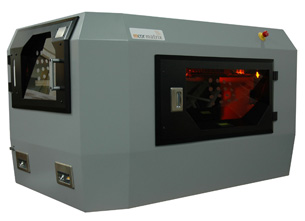Desktop Manufacturing Moves in with the Furniture
Office-based equipment, whether 3D printing or subtractive, offers true 3D parts at why-not pricing.
Latest News
May 3, 2009
By Pamela J. Waterman
 The Dimension uPrint 3D Printer in three colors. Image courtesy Dimension 3D Printing Group. |
Clear a little space off your desk. It could be time for one of today’s office-friendly rapid manufacturing systems. While these systems are now sleek enough to park next to a favorite 2D printer, make no mistake, you’ll be building true 3D parts.
DE took a look at equipment that can easily sit on a desk or table, plug into a standard 110V outlet, and is clean and quiet. We’ve also included freestanding systems from three companies that otherwise meet the checklist. In all, we’ve come up with more than a dozen candidates with resolutions, material choices, speed, and prices to complement or even replace your current processes.
Serious Parts Right at Your Side
Growing and evolving for more than 20 years, the rapid manufacturing industry has never been dominated by just one or two technologies. From laser-curing UV photopolymers to jetting liquid plastics, engineers continue to produce increasingly compact and unique systems.
Designed specifically for the office environment, the Desktop Factory 125ci 3D Printer uses an inexpensive halogen light source and drum printing technology to build robust parts from composite plastic powder. Backed by almost five years of careful, consumer-driven R&D, the company has focused its efforts on an easy-to-use, safe, and affordable product; $4,995.
The Desktop Factory printer measures 17 in. x 25 in. x 20 in. and weighs less than 90 pounds. Its build envelope is 5 in. x 5 in. x 5 in., and the first available material is a gray nylon-based powder that produces parts tough enough to be tapped, milled, sanded, and painted. Support material is easily removed with a brush or small instrument. The system accepts STL input, checks it for accuracy, performs some file repairs, and manages the printing process from a PC or workstation. Desktop Factory is aiming to ship its first systems in the near future.
 Desktop-sized Alaris 30 from Objet Geometries. Image courtesy Objet Geometries |
At the opposite end of the timeline, 3D Systems, the granddaddy of the rapid manufacturing world, continues its phased rollout of the V-Flash FTI 230 Desktop Modeler, its plug-and-play system for business, hobby, and school; $9,900. The unit is 26 in. x 27 in. x 31 in. high, and weighs 145 pounds; maximum build size is 9 in. x 6 ¾ in. x 8 in.
The FTI in the name stands for film transfer imaging, the technology behind the modeler. Key to the system’s operation is the V-Flash Cartridge. This closed, self-contained cartridge is a complete solution that, according to 3D Systems, consumes two to three times less material than other 3D modeling and printing technologies. Parts look like an off-white plastic and can be sanded, drilled, painted, glued, and plated. The cartridge approach reduces printer maintenance by incorporating material handling wear components into a high-precision, disposable format.
Dimension 3D Printing Group, a business unit of Stratasys, recently entered the desktop arena with its uPrint Personal 3D Printer; $14,900. Designed to cut traffic at centralized company equipment, the uPrint system runs quietly in an office environment and operates from a PC with either Windows XP or Windows Vista.
Sized at 25 in. x 26 in. x 31 in., with build-volume dimensions of 8 in. x 6 in. x 6 in., the uPrint 3D Printer builds models based on Stratasys FDM (fused deposition modeling) technology. The system currently offers ABSPlus build material in ivory and uses a hands-free, soluble support removal system. Parts emerge ready to use for form, fit, and function, or can be postprocessed with drilling, tapping, machining, sanding, painting, and chrome plating.
An optional second material bay installs under the uPrint unit, offering the flexibility of reloading materials during printing. The unit also one-ups most office equipment by coming in your choice of three colors, gray, red, or green.
A line of office-friendly milling machines from Roland DGA cuts detailed parts in wood, plaster, modeling wax, non-proprietary plastics, and non-ferrous metals. Its desktop CNC milling technology solves many desktop manufacturing challenges. The smallest systems start at $3,145 (MDX-15) and $4,695 (MDX-20), while larger systems range from $7,345 up to $36,795.
 The Matrix layered-paper laminating system from Mcor Technologies. |
The MDX-15’s dimensions are approximately 16 in. x 11 in. x 12 in. while the MDX-20 measures 18 in. x 15 in. x 12 in.; weights are 21 pounds and 30 pounds, respectively. Models increase in spindle speed and work volume, and are larger though they can still work on a desk or table. Designed with dust enclosures for safe desktop operation, the Roland DGA units plug into standard wall outlets and include wizard-based CAM software; no CNC experience is necessary.
Another system ideal for the office environment comes from Objet Geometries—the Alaris30. Objet’s PolyJet Inkjet technology works by jetting photopolymer materials in layers that are cured with UV light; no post-curing is required. A gel-like support material is easily removed with a water-jet or by hand, and the materials are supplied in sealed 1kg cartridges. The company’s proprietary material for this machine is the opaque white VeroWhite FullCure 830, which creates a fine surface finish of parts within a build volume of approximately 11.5 in. x 7.7 in. x 6 in.
Users submit a CAD model in STL file format then the Alaris30’s printer software, Objet Studio, takes over print job management, tray placement, and orientation. The unit’s dimensions are approximately 32 in. x 24 in. x 23 in. and it weighs 183 pounds. The Alaris30 sells for less than $40,000.
Solidscape continues to expand its market for high-precision parts beyond the jewelry and dental industries with its R66, T76, and T612 Benchtop system. Sized at 22 in. x 19 in. x 16 in., the R66 is a true office peripheral that runs with Windows software and industry-standard jewelry software, and offers a build volume of 6 in. x 6 in. x 4 in. The similarly sized T76 offers the same resolution but a faster build speed and both weigh 88 pounds; the slightly larger T612 Benchtop expands the build volume to 12 in x 6 in. x 6 in., with a weight of 96 pounds.
The non-hazardous materials used in Solidscape systems are a cyan thermoplastic build material (InduraCast), ideal for investment casting and a purple wax (InduraFill) that serves as a sacrificial support material; the latter is dissolved in a mineral oil bath after the model is complete. Solidscape’s technology is based on inkjet printing and jets both materials simultaneously from two heads. Pricing starts at $35,650.
Updates in the Rapid Technologies World • Industry consultant Terry Wohlers of Wohlers Associates recently blogged about an observation he made at SolidWorks World, the annual conference for customers of the 3D CAD software vendor. He said, “If the event had a theme, it would have been 3D printing. You didn’t have to look far or listen long to see or hear about it.” He went on to list speaker after speaker who either displayed parts made with some form of 3D printing (a term that covers most types of rapid manufacturing) or named 3D printing as a key trend that will impact the future of CAD. (wohlersassociates.com/blog) • Z Corporation’s ZPrints service is now embedded within Autodesk software. Designers and engineers can click a button in AutoCAD 2009 and directly order a 3D model to be built on a ZCorp system through Quickparts, a service provider. • The 4th International Conference on Advanced Research in Virtual and Rapid Prototyping (VRAP 2009), Leiria, Portugal, October 6-10, 2009 will cover a wide range of topics in rapid manufacturing, including materials and advanced technologies (vrap.ipleiria.pt) —PJW |
Envisiontec’s Perfactory Desktop System measures 24 in. x 24 in. x 43 in., with a largest part size of 10 in. x 7.5 in. x 8 in. The system uses photo-cured resins in a choice of materials to produce high-resolution conceptual to fully functional parts. Post-processing is done with standard isopropyl alcohol. Units are priced under $45,000.
Building Parts One Sheet at a Time
The SD300 3D Printer from Solido uses plastic sheet lamination (delivered on a roll) to create rugged yet flexible parts; the bonding process combines glue from a cartridge with sheets of thin PVC-based plastic. The raw sheet material comes in clear, red, blue, black, and cream colors. Parts can be machined, drilled, finished, and painted.
Incoming STL files are converted to proprietary SDM output files; maximum model size for Solido parts is approximately 6 in x 8 in. x 5 in. Overall dimensions are 18 in. x 30 in. x 16 in., so the unit can sit on a desktop and be controlled from a nearby workstation. The SD300 plugs into standard wall outlets, requires no special environmental considerations, and weighs 99 pounds; $14,000 to $17,000. Solido will soon be releasing an even lower cost system.
Mcor Technologies currently markets its laminated paper Matrix system in Ireland and the UK, but is planning on a US release this year. The system uses standard office paper, a water-based adhesive, and a cutting blade to produce durable, eco-friendly parts with the appearance of a wood carving. In-house Slice-It software from Mcor controls the process on STL files, and the company’s efficient, patented Eco-Physualiser selectively deposits lower levels of adhesive on the parts that form any necessary break-away support structure. Final parts can be sanded and treated with a cyanoacrylate for water resistance.
The Matrix measures approximately 45 in. x 30 in. x 30 in., with a build volume of 573 cubic inches. One new effort under consideration is to allow use of A3 or 11 in. x 17 in. sheets. The units will sell in the range of $15,000-20,000, but the company stresses the significance of its minimal material costs.
Desk-Side Systems
Not exactly designed for the desktop, but definitely office-friendly are systems from ZCorporation, Dimension 3D Printing Group, and 3D Systems.
ZCorporation is known for its full-color printing systems but still offers the monochrome Z310 model starting at $19,900. Like its higher end (and larger) siblings, the Z310 operates quietly on standard power with no excessive heat, noise or chemical hazards, and offers full recyclability of unused powder. All controls for this ink-jet-printer-like system show up on the user’s PC window, and the operation is simple enough that a casual user can easily work with it. The Z310’s build volume is 8 in. x 10 in. x 8 in., and the overall size is 29 in. x 24 in. x 43 in.
Dimension sells five additional models beyond its uPrint that also offer larger build volumes and produce parts in a variety of colored materials. The 768 series has a build size of 8 in. x 8 in. x 12 in. and uses ABS, the 1200 series builds up to 10 in. x 10 in. x 12 in. in ABSPlus, and the Elite creates parts up to 8 in. x 8 in. x 12 in. but with the finest level of detail. All models operate on standard power with no venting or special handling required.
And coming back to 3D Systems, the company’s ProJet line of compact manufacturing systems comes in five free-standing models with variations targeted to the dental, jewelry, and mechanical industries. Based on the company’s Multi-Jet Modeling technology, these systems work with one or more of five types of available material. Build volume is 12 in. x 7 in. x 8 in., and the unit size is 29 in. x 50 in. x 59 in.
So, whether you literally want to create parts on your desktop or you’re happy to share a little space with a unit that’s about the size of a high-end copy machine, you’ll find a fascinating range of options that put rapid manufacturing right inside your office door.
More Info:
3D Systems
Rock Hill, SC
Desktop Factory
Pasadena, CA
Dimension 3D Printing Group
Eden Prairie, MN
Envisiontec
Ferndale, MI
Mcor Technologies
Ardee, Ireland
Objet Geometries, Inc.
Billerica, MA
Roland DGA Corp
Irvine, CA
Solido
Yehud, Israel
Solidscape
Merrimack, NH
Wohlers Associates
Ft. Collins, CO
Z Corporation
Burlington, MA
Contributing Editor Pamela J. Waterman is an electrical engineer and freelance technical writer based in Arizona. You can contact her about this article via e-mail sent to [email protected].
Subscribe to our FREE magazine, FREE email newsletters or both!
Latest News
About the Author
Pamela Waterman worked as Digital Engineering’s contributing editor for two decades. Contact her via .(JavaScript must be enabled to view this email address).
Follow DE





